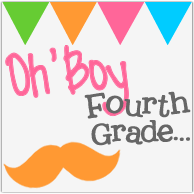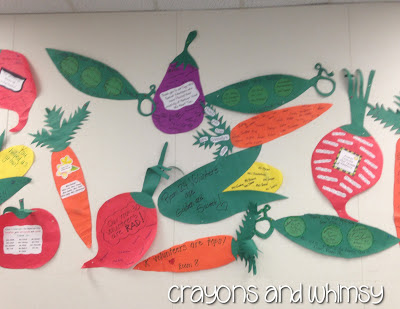Throughout my 14 years of teaching (holy moly has it been that long!) I have always heard the term "Balanced Literacy" and I've actually heard more than one definition of what exactly it means. So I'm going academic in today's post....maybe I miss those term papers I used to write? I hope this post is at least a little more entertaining than a term paper!
As we move in to Common Core some serious changes are happening...that being said, kids are still kids, words are still words and our brains still work in the same way....
So here is my two cents on the subject of Balanced Literacy:
How do we "balance" all of the components?
Let's break it down.
Balanced Literacy has three main facets:
1. Reading
2. Writing
3. Word Study
And it is important for students to learn all of these skills simultaneously.
Today's post will look look at READING which is made up of phonemic awareness, phonics, fluency and vocabulary. This includes:
Reading Aloud {Teacher reads a selection aloud to students}
*Develops vocabulary
*Exposes students to different genres
*Develops listening
*Encourages classroom conversations about text
*Provides adult model of fluent reading
And for the record, read aloud is appropriate at all age levels. Jim Trelease says, "The first reason to read aloud to older children is to consider the fact that a child's reading level doesn't catch up to his listening level until about eighth grade." This quote and other research on the subject can be found in this article {HERE} I told you I was going academic....referencing data {this really is term paper style today}
Shared Reading {Teacher and students read together}
*Promotes reading strategies
*Rich literature can be used
*Develops fluency and tracking skills
*Can focus on story elements (characters, setting, plot)
*Students practice taking turns
Sometimes in my kindergarten classroom Shared Reading will include the kiddos echoing me, or chanting poems they are very familiar with as I (or a child) tracks.
Independent Reading {Students read independently}
*Develops fluency
*Vocabulary development
*Builds background and schema
*Problem solves independently {I know... not so much for the really little guys}
"The amount of time students spent in independent reading was the best predictor of reading achievement and also the best predictor of the amount of gain in reading achievement made by students between second and fifth grade." (Anderson, Wilson and Fielding, 1988) OK so 1988 was a lifetime ago and times change... but I think it is so well said and I think it is still true.
And again, for you teachers of the little guys, independent reading can be using very simple emergent texts or "reading" a book a child has memorized...which definitely improves confidence on top of introducing print.
Guided Reading {Teacher and a small group of students read a text at the students' instructional level}
*Encourages independent reading
*Builds confidence
*Works on fluency, sound blending
*Comprehension strategies are introduced
Tomorrow I will talk about the At home connection regarding reading... can you say important?! There will be a few Freebies for your parents too!
2
As we move in to Common Core some serious changes are happening...that being said, kids are still kids, words are still words and our brains still work in the same way....
So here is my two cents on the subject of Balanced Literacy:
How do we "balance" all of the components?
Let's break it down.
Balanced Literacy has three main facets:
1. Reading
2. Writing
3. Word Study
And it is important for students to learn all of these skills simultaneously.
Today's post will look look at READING which is made up of phonemic awareness, phonics, fluency and vocabulary. This includes:
Reading Aloud {Teacher reads a selection aloud to students}
*Develops vocabulary
*Exposes students to different genres
*Develops listening
*Encourages classroom conversations about text
*Provides adult model of fluent reading
And for the record, read aloud is appropriate at all age levels. Jim Trelease says, "The first reason to read aloud to older children is to consider the fact that a child's reading level doesn't catch up to his listening level until about eighth grade." This quote and other research on the subject can be found in this article {HERE} I told you I was going academic....referencing data {this really is term paper style today}
Shared Reading {Teacher and students read together}
*Promotes reading strategies
*Rich literature can be used
*Develops fluency and tracking skills
*Can focus on story elements (characters, setting, plot)
*Students practice taking turns
Sometimes in my kindergarten classroom Shared Reading will include the kiddos echoing me, or chanting poems they are very familiar with as I (or a child) tracks.
Independent Reading {Students read independently}
*Develops fluency
*Vocabulary development
*Builds background and schema
*Problem solves independently {I know... not so much for the really little guys}
"The amount of time students spent in independent reading was the best predictor of reading achievement and also the best predictor of the amount of gain in reading achievement made by students between second and fifth grade." (Anderson, Wilson and Fielding, 1988) OK so 1988 was a lifetime ago and times change... but I think it is so well said and I think it is still true.
And again, for you teachers of the little guys, independent reading can be using very simple emergent texts or "reading" a book a child has memorized...which definitely improves confidence on top of introducing print.
Guided Reading {Teacher and a small group of students read a text at the students' instructional level}
*Encourages independent reading
*Builds confidence
*Works on fluency, sound blending
*Comprehension strategies are introduced
Tomorrow I will talk about the At home connection regarding reading... can you say important?! There will be a few Freebies for your parents too!





































































